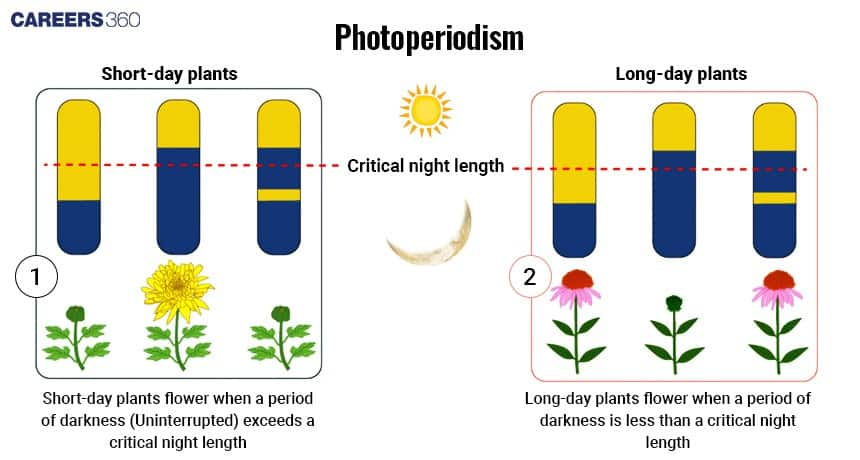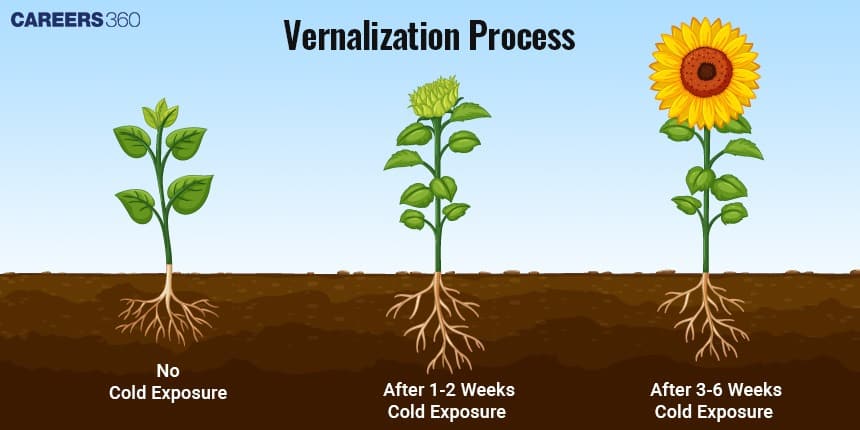Difference Between Photoperiodism And Vernalisation: Vernalization And Photoperiodism
Photoperiodism and vernalisation are two major environmental cues that regulate flowering by sensing day-length and cold exposure, respectively. While photoperiodism depends on light/dark cycles, vernalisation requires prolonged low temperatures to induce or accelerate flowering. These mechanisms are essential NEET concepts under plant physiology and seasonal adaptation.
This Story also Contains
- Introduction To Photoperiodism And Vernalisation
- What Is Photoperiodism?
- What Is Vernalisation?
- Key Differences Between Photoperiodism And Vernalisation
- Importance in Agriculture & Ecology
- Photoperiodism vs Vernalisation NEET MCQs (With Answers & Explanations)
- Recommended Video on Difference Between Photoperiodism And Vernalisation

Introduction To Photoperiodism And Vernalisation
Plants have evolved a high degree of complexity to act against fluctuations in seasons to ensure their survival and propagation. Two prominent modules that cause plants to respond based on external factors include photoperiodism and vernalization. While both of these processes involve some form of perception concerning an external factor followed by regulation over flowering, the two are relatively dissimilar.
What Is Photoperiodism?
Photoperiodism is the response of plants to the relative length of day and night. Plants use specialized photoreceptor proteins, phytochromes and cryptochromes to sense changes in light/dark periods. Based on their response to photoperiod, plants could be classified into three general groups. Photoperiodism, more generally, is considered to be the biological response of plants to the relative length of day and night.

Photoreceptors Involved
Plants make use of specialized photoreceptor proteins known as phytochromes and cryptochromes to perceive changes in light/dark periods.
Types of Plants Based on Photoperiod
Based on their response to photoperiod, plants are categorized into three main groups:
Long-Day Plants: Those requiring a longer light exposure to induce flowering (LDP).
Short-Day Plants: Require shorter exposure to light to induce flowering
Day-Neutral Plants: Flower irrespective of day length
Mechanism Overview
The mechanism of photoperiodic flowering involves the perception of the light/dark signals by photoreceptors, transduction of signals to the leaves and synthesis of a floral stimulus-florigen, followed by its transport to the shoot apical meristem, and induction of flowering genes.
What Is Vernalisation?
Vernalization is the process by which some plants require an extended period of exposure to cold temperatures before they can complete the flowering process. This adaptation enables flowering to take place at the appropriate time. In contrast to photoperiodism, vernalization is a quantitative response, namely, the duration of cold exposure impacts the degree of flowering induction.

Why Vernalisation is Needed
Vernalisation is needed because:
Prevents premature flowering
Ensures flowering occurs in favorable seasons
Common in winter cereals like wheat, barley, rye
Mechanism Overview
In other words, vernalization will be the perception of the cold signal by plants and will have subsequent epigenetic changes in flowering genes. These modifications become fixed and are sustained even following the removal of the cold treatment, allowing flowering under conducive environmental conditions.
Key Differences Between Photoperiodism And Vernalisation
The differences between photoperiodism and vernalisation is given in the table below:
Characteristic | Photoperiodism | Vernalisation |
Definition | Response of plants to the relative length of day and night | A process requiring exposure to cold temperatures for flowering |
Stimulus | Length of light and dark periods | Prolonged exposure to low temperatures |
Perception | Detected by photoreceptors (phytochromes, cryptochromes) | Perceived by protein complexes interacting with flowering genes |
Categorization | Divided into long-day, short-day, and day-neutral plants | No clear categorization; varies among plant species |
Response Type | Qualitative response, flowering occurs based on light exposure | Quantitative response; duration of cold affects flowering induction |
Epigenetic Changes | No long-lasting epigenetic modifications | Leads to epigenetic changes that persist after cold treatment |
Function | Induces flowering based on day length | Prepares plants for flowering after cold exposure |
Importance in Agriculture & Ecology
The importance in agriculture and ecology:
Synchronises flowering with season: Ensures that flowering occurs at the appropriate time of the year, so that conditions are favorable for pollination.
Used in crop scheduling: Allows farmers to control and predict the time of fruiting and flowering for uniform harvesting.
Helps extend crop cultivation to new climates: By regulating growth and flowering through hormones, crops can be successfully grown in variable climatic regions.
Photoperiodism vs Vernalisation NEET MCQs (With Answers & Explanations)
Important topics for NEET are:
Types of Plants based on photoperiodic response
Long-day plants vs Short-day plants vs Day-neutral plants
Mechanism of Photoperiodic flowering
Practice Questions for NEET
Q1. Which of the following plants belong to long short Day plants (LSDP)?
Hyoscyamus niger
Bryophyllum cestrum
Oryza sativa
Zea mays
Correct answer: 2) Bryophyllum cestrum
Explanation:
Long short Day plants (L-SDP) -
Plants require long photoperiods for floral initiation and short photoperiods for blossoming. When they get more than 12 hours of light per day—typically 14–16 hours—they bloom. Another name for them is short night plants. Plants flower between summer and autumn. Eg. Bryophyllum Cestrum
Hence, the correct answer is Option (2) Bryophyllum cestrum
Q2. Photoperiodism is the
Response of plants to the changing environmental conditions
Response of plant to the low temperature treatment expressed in the form of flowering
Response of plants to the photoperiod expressed in the form of flowering
Response of plants to the quality of light expressed in the form of seed germination
Correct answer: 4) Response of plants to the photoperiod expressed in the form of flowering
Explanation:
The response of plants to the photoperiod expressed in the form of flowering is called photoperiodism. Photoperiodism is controlled by photoreceptor proteins like phytochromes and cryptochromes, which sense the duration of light and dark periods. Plants are classified based on their flowering response into short-day, long-day, and day-neutral plants. This mechanism helps plants synchronize their reproductive cycles with favorable environmental conditions.
Hence, the correct answer is option 3 - the response of plants to the photoperiod expressed in the form of flowering.
Q3. Long day plants produces flowers when they exposed to
Any duration of light
Light period longer than a critical day length
Light period longer than 12 hours
Light period shorter than a critical day length
Correct answer: 2) Light period longer than a critical day length
Explanation:
The critical photoperiod is the length of time that must be exposed to light for some plants to flower. This varies among species and is important for their reproduction.
Key Terms
Long-Day Plants: These plants need a light period longer than a certain number of hours (the critical photoperiod) to begin flowering. They tend to bloom in late spring or early summer when days are longer.
Examples: Some common long-day plants are:
Spinach
Lettuce
Some Wheat Types
Light exposure past the critical photoperiod causes these plants to begin producing flowering hormones, causing the transition from vegetative growth to flowering. Knowledge of critical photoperiods is critical for agriculture as it determines the timing of planting schedules and crop yields.
Hence, the correct answer is option 2) Light period longer than a critical day length.
Also Read:
Recommended Video on Difference Between Photoperiodism And Vernalisation
Frequently Asked Questions (FAQs)
Photoperiodism is a response to the relative length of the day and night, whereas vernalization is a response to prolonged cold temperatures.
Photoperiodism is perceived by photoreceptors such as phytochromes and cryptochromes, while vernalization is perceived by some complex proteins which interact with flowering genes.
The quantitative response of vernalization is that the length of cold exposure influences the extent of flowering induction, and plants modulate their flowering response based on the environment.
Flowering genes go through epigenetic modifications via the process of vernalization. Though the cold treatment is removed, epigenetic changes persist, and plants flower at appropriate times.
Yes, some plants can integrate both photoperiodic and vernalization signals to optimize their flowering response to seasonal changes.